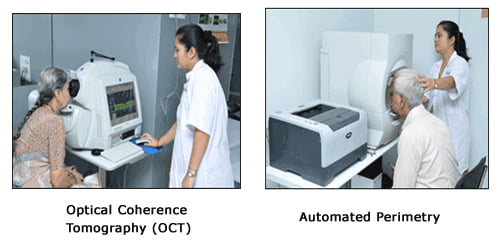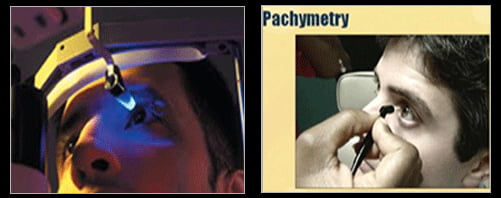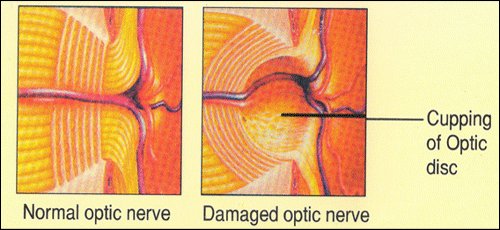
Book Your 1st Free Appointment
SAVING SIGHT Glaucoma Clinic
Done by State-of-the-Art diagnostic and therapeutic modalities :
ZEISS HUMPHREY PERIMETER : State-of-the-Art visual field analyzer.
OCT for measurement of retinal nerve fibre thickness for earliest detection of Glaucoma.
The Ocular Response Analyzer

The Ocular Response Analyzer is a novel instrument for measuring the intraocular pressure (IOP) of the eye. It is also the only instrument capable of measuring the biomechanical properties of the cornea. Corneal biomechanical properties influence intraocular pressure measurement, undergo alterations in corneal pathology and following corneal refractive surgery. Corneal Hysteresis (CH), which is the result of viscous damping in the corneal tissue, is a new indicator of corneal biomechanical properties.
The Glaucoma dept of Anil Eye Hospital is now equipped with the Ocular response Analyzer, a latest and novel technique to measure Intraocular pressure.
Basic monitoring equipment like the Ophthalmoscope, non contact and applanation tonometry, Pachymeter and Gonioscope for complete Glaucoma workup.
Laser procedures and surgery for the management of Glaucoma.
Eye produces fluid called aqueous humor within it and this fluid performs the functions of lubricating and nourishing certain parts of the eye. This fluid then gets drained in the blood stream. A dedicate balance is maintained between production and drainage of this fluid so as to exert normal fluid pressure inside the eye, known as intraocular pressure. The optic nerve arises from the retina, the innermost layer of the eye, and carries messages to the brain which is responsible for interpretation of image
What is Glaucoma?
Glaucoma is an eye disease and a leading cause of blindness the world over. It is a condition which causes an abnormally high intraocular pressure inside the eye. The high pressure silently damages the optic nerve and blood vessels that nourish the retina. Once optic nerve is damaged, gradual loss of vision takes place. Damage to the optic nerve takes place slowly that the person usually is not aware of the gradual loss of vision. Vision gradually becomes more and more impaired until irreversible blindness sets in which is called Absolute Glaucoma.

What are the symptoms of Glaucoma?
90% of patients do not show any symptoms; hence it is called ‘Silent killer’ of the optic nerve.
Gradual loss of peripheral vision.
Dull pain around the eye after staying in dark e.g. after coming out of cinema theatre.
Seeing coloured rings around artificial light specially in early morning or at night.
Frequent changes in reading glasses.
Poor vision in the night.
Blurred or foggy vision
How is Glaucoma diagnosis conducted?
Glaucoma is detected during routine and regular eye examinations.Your Eye Doctor will perform
Tonometry i.e. measure intraocular pressure of your eye.
Gonioscopy i.e. inspect drainage angle of your eye.
Ophthalmoscopy i.e. examines and judge optic nerve damage of your eye, if any.
Disc Photography to record optic disc details.
Automated Perimetry i.e. test the visual field of each eye.
Pachymetry – Use to measure corneal thickness.
Optical Coherence Tomography (OCT) – It is non invasive imaging modality, for the earliest detection of Glaucoma, It gives exact measurement of retinal nerve fibre layer


Who are at Risk?
Anyone can suffer from glaucoma. But some people are at more risk than others and risk factors are :
Increasing age
Nearsightedness
Family history of glaucoma-children & siblings of known glaucoma patients should get their eyes checked regularly.
Family history of glaucoma-children & siblings of known glaucoma patients should get their eyes checked regularly.
Previous eye injuries or surgeries.
Other diseases such as diabetes or high blood pressure.
Thin Corneas are a risk factor for Glaucoma
How is Glaucoma treated?

However, early treatment can limit further loss of vision. The objective of treating glaucoma is to lower eye pressure and can be done with the help of
Medicines i.e. eye drops & tablets.
Laser Surgery
Filtration Surgery
Medicines
This part of the treatment is the most important. Some eye drops reduce the amount of fluid produced by eyes whereas others increase drainage of fluid from the eyes.
You must use your medicines as directed by your ophthalmologist. You must not stop medicines even if you do not have symptoms.
When glaucoma cannot be controlled with the help of medicines or when patients are unable to tolerate the side effects of the medicines, the following procedures maybe used to improve drainage of fluid by your ophthalmologist.
Laser Surgery
Laser produces high energy beam of light to increase drainage of excess fluid thereby lowering pressure inside the eye. Laser procedures may be effective only in certain cases.
Anti Glaucoma Filteration Surgery
In cases where medicines & laser do not help to reduce the eye pressure to the desired level, surgery may need to be performed. Filtration surgery can be done to create a new drainage channel to facilitate drainage of excess fluid, thereby lowering pressure inside the eye.
Can Glaucoma be prevented?
No, Glaucoma unfortunately cannot be prevented, but early detection and treatment can prevent loss of vision due to glaucoma. Hence, all patients past age of 40 yrs should get their eye checked once a year by a qualified eye doctor.
Anil Eye Hospital provides facilities for ‘Complete Glaucoma Workup’ for early detection & treatment of Glaucoma.We also conduct screening camps to increase awareness about glaucoma. Anil Eye Hospital has developed a Glaucoma Support group for it’s patients & has been holding annual symposia since the last 3 years.
